High-Temperature Allowance in China: FIEs’ Compliance Checklist
China high-temperature allowance compliance is essential for foreign-invested enterprises operating during the country’s extreme summer heat. This article breaks down who qualifies, how much should be paid, and the regional differences employers need to navigate, helping HR and payroll teams stay compliant while building employee trust.
As China experiences increasingly frequent and prolonged summer heatwaves, labor protections tied to extreme temperatures have come under greater regulatory scrutiny. Among these, the high-temperature allowance stands out as a core compliance requirement for employers, mandated under national regulations and supplemented by local standards.
Again, for foreign-invested enterprises (FIEs) operating in China, understanding and implementing high-temperature allowances is not just a matter of local goodwill—it’s a legal obligation. Failure to comply with payment requirements, eligibility rules, or documentation standards may expose companies to labor inspections, administrative penalties, or employee disputes.
First introduced in the early 2000s and formalized through the 2012 Administrative Measures for Heatstroke Prevention and Cooling Measures, China’s high-temperature allowance policy requires employers to compensate eligible employees working under hot conditions. However, specific standards, such as payment amount, months of coverage, and local enforcement practices, vary significantly by region.
This article provides a practical and up-to-date guide to China’s high-temperature allowance rules. It explains the national legal framework, highlights regional implementation differences, and offers tailored advice for FIEs to stay compliant while aligning with internal HR and payroll systems.
Who is entitled to the high-temperature allowance in China?
The high-temperature allowance is a mandatory form of compensation designed to protect workers exposed to excessive heat in their working environment. According to Chinese labor laws and the Administrative Measures for Heatstroke Prevention and Cooling Measures, eligibility is based primarily on actual working conditions, rather than employment type or industry. FIEs must understand these distinctions to ensure compliance and avoid labor disputes.
Eligible working conditions
An employee qualifies for high-temperature allowance if they meet either of the following conditions:
- Outdoor (open-air) work: Employees working outdoors on days when the daily maximum temperature reaches 35°C or above;
- Indoor high-temperature work: Employees working in environments where indoor temperatures cannot be reduced below 33°C through effective cooling measures.
Regional note: Some provinces, such as Shanghai, apply fixed seasonal coverage (such as June to September) and determine eligibility based on working conditions, not on whether the daily temperature actually hits 35°C. FIEs should always consult local rules.
What about part-time and hourly workers?
Although national law does not explicitly mandate high-temperature allowances for non-full-time or hourly-paid workers, employers are expected to consider such compensation when these workers are assigned to high-temperature roles. In practice, the hourly wage arrangement should incorporate heat compensation where applicable. A common approach is to calculate the high-temperature allowance proportionally, based on actual hours worked during qualifying conditions.
Coverage across worker categories
FIEs must ensure that high-temperature allowances are extended fairly across different types of employment relationships, including:
- Formal and temporary employees: This includes direct hires, dispatch workers, and interns, if their roles meet the heat exposure criteria;
- Outsourced workers: If the labor service provider fails to pay the allowance, the hiring entity may bear joint liability, unless responsibilities are clearly defined in the contract; and
- Foreign employees in China: Foreign nationals working under Chinese labor contracts are also entitled to high-temperature allowances, provided they meet the same working condition thresholds.
Common misunderstandings
Many employers, especially new market entrants, fall into avoidable compliance traps. Two frequent misconceptions include:
- Misconception 1: “Only manual laborers are eligible.”
In fact, any worker exposed to high-temperature environments qualifies—this includes roles such as data center technicians or kitchen staff whose workplaces may exceed 33°C indoors. - Misconception 2: “Trial or probationary employees are excluded.”
High-temperature allowance is a statutory entitlement and applies regardless of employment duration, probation status, or contract type.
Typical roles covered
Understanding which job types typically fall under high-temperature allowance rules helps companies implement targeted compliance:
- Outdoor workers: Construction workers, sanitation staff, delivery couriers, traffic assistants;
- Indoor high-heat roles: Foundry and smelting workers, glass furnace operators, chefs, boiler room staff; and
- Special cases: Agricultural laborers, field engineers, and utility repair crews working under extreme weather conditions.
How much is the high-temperature allowance in China?
One of the most frequently asked questions from foreign employers is: How much should we pay for high-temperature allowance, and for how long? While the national regulation provides the legal framework, the specific standards, such as amount, payment method, and payment period, are determined at the provincial level. As of now, at least 28 provinces and municipalities in China have issued their own guidelines, with notable variations across regions.
Payment period: Ranges from 4 to 7 months
Different provinces define different months as eligible for high-temperature allowance, largely based on local climate patterns. The allowable period generally falls between April and October, with most provinces focusing on the peak summer months.
- Hainan has the longest coverage, requiring allowance payments from April through October (seven months total);
- Beijing, Shanghai, Guangdong, and Zhejiang follow the standard four-month window of June to September; and
- In northeastern provinces such as Liaoning and Jilin, where summers are milder, allowance payments are typically limited to June through August.
Tip for employers: Even if the temperature does not hit 35°C every day, some local policies define fixed months for payment, meaning employers must pay during that period regardless of actual weather.
Payment standards: Monthly, daily, or hourly
China’s provinces adopt different payment methods based on local guidelines. These methods fall into three main categories:
- Monthly fixed amount (most common): Many provinces, including Shanghai, Jiangsu, Zhejiang, and Guangdong, require high-temperature allowances to be paid monthly, usually ranging from RMB 200 to 300 per month.
- Daily payment: Some provinces, such as Shaanxi, mandate a daily rate of RMB 25 per workday during the June–September period.
- Hourly or proportional calculation: A few regions allow employers to calculate the allowance based on actual working hours in heat-exposed environments or as a proportion of regular income. This approach is more complex and typically used for irregular work arrangements.
Payroll note: The high-temperature allowance must be paid in money, and cannot be substituted with drinks, cooling supplies, or in-kind benefits. Employers must also retain accurate records to demonstrate compliance during labor inspections.
For FIEs, maintain a localized payroll compliance calendar that reflects the regional allowance period and method. If your company operates across provinces, you must follow local rules for each location—there is no unified national rate or timeline.
|
High-Temperature Allowance Standards in China by Region |
||
| Region | Allowance standard (RMB) | Payment period |
| Anhui | ≥15 per workday | Not specified |
| Beijing | Outdoor work: ≥180/month; Indoor (≥33°C): ≥120/month | June–August |
| Chongqing | General: ≥5/day; Moderate heat: ≥10/day; Intense heat: ≥15/day; Indoor: 5–15/day depending on temperature | Not specified |
| Fujian | ≥12/day (actual hot days); or ≥260/month (monthly method) | May–September |
| Gansu | Outdoor/high-heat: 12/day; Other work: 8/day (based on attendance) | June–September |
| Guangdong | 300/month (or 13.8/day if calculated daily) | June–October |
| Guangxi | Monthly: 250–300/month; Daily: 11.5–13.8/day | June–October |
| Guizhou | 8/day or 168/month | June–September |
| Hainan | 10/day | April–October |
| Hebei | Outdoor: ≥2/hour; Indoor (no cooling or ineffective cooling): ≥1.5/hour | Based on actual work hours |
| Henan | ≥15 per workday | June–September |
| Hubei | 12/day | June–September |
| Hunan | ≥300/month | July–September |
| Inner Mongolia | 180/month | 1–3 months (local policy) |
| Jiangsu | 300/month | June–September |
| Jiangxi | Outdoor/high-heat: ≥300/month; Indoor non-heat: ≥200/month; Daily: ≥20/day; Part-time: ≥3/hour | June–September |
| Jilin | 200/month | June–August |
| Liaoning | 200/month | July–September |
| Ningxia | Outdoor/high heat: 12/day; Other work: 8/day (based on attendance) | June–September |
| Shaanxi | 25/day | June–September |
| Shandong | Outdoor/high heat: 300/month; Other work: 180/month | June–September |
| Shanghai | 300/month | June–September |
| Shanxi | On-duty workers: 240/month | June–August |
| Sichuan | 13–23/day | Not specified |
| Tianjin | 12% of last year’s average daily wage (paid monthly, calculated daily) | Based on actual hot days |
| Xinjiang | 10–20/day | June–September |
| Yunnan | 10 per workday | Not specified |
| Zhejiang | Outdoor: 300/month; Indoor: 200/month | June–September |
Note: This table reflects local government policies as of 2025. For implementation, always verify with local authorities or HR/legal advisors to ensure accuracy and compliance with current standards.
High-temperature allowance vs. cooling subsidies: What’s the difference, and how are they taxed?
In China’s summer labor compliance framework, two distinct forms of employee compensation often arise: the high-temperature allowance (高温津贴) and cooling subsidies or summer welfare payments (防暑降温费). While these two terms are sometimes used interchangeably, they are legally and financially very different in terms of purpose, obligation, scope, and tax treatment. Understanding this distinction is essential for FIEs to ensure compliance, manage costs properly, and avoid confusion during audits or inspections.
High-temperature allowance: Mandatory, wage-related, and tax-deductible in full
The high-temperature allowance is a statutory benefit. It is mandated by law and applies specifically to employees working under high-heat conditions, such as outdoor labor in temperatures exceeding 35°C or indoor workplaces where the temperature cannot be reduced below 33°C. This allowance is a part of wages and must be paid in cash, not replaced with in-kind goods like drinks or cooling products.
Importantly, this allowance is excluded from minimum wage calculations—it must be paid in addition to the employee’s base wage.
From a tax perspective, high-temperature allowances are fully deductible for corporate income tax (CIT) purposes. According to Article 34 of the Implementation Regulations of the CIT Law, all reasonable wage and salary expenses, including subsidies and allowances that form part of compensation, can be deducted from taxable income.
Tax tip: So long as the high-temperature allowance complies with applicable local rules and is recorded as part of payroll, it is fully deductible before tax.
Cooling subsidies: Optional, welfare-based, and subject to deduction caps
Cooling subsidies are not legally mandated. Instead, they are classified as employee welfare expenses and can be provided in cash or in-kind (for example, herbal tea, electrolyte drinks, sun hats, and cooling oil) to all on-duty employees during summer, regardless of whether they work in heat-intensive environments.
The standard and form of this benefit is determined by the enterprise itself, through internal HR policies or collective agreements.
However, unlike the high-temperature allowance, cooling subsidies are not fully tax-deductible. They fall under the category of welfare expenses and are subject to a cap. According to Article 40 of the Implementation Regulations of the CIT Law, only employee welfare expenses up to 14 percent of total wages and salaries are deductible. Any amount beyond this limit is not eligible for pre-tax deduction.
Tax tip: Cooling subsidies should be properly documented under the welfare category and counted toward the 14 percent deduction cap on employee welfare expenses.
|
Comparison: High-Temperature Allowance vs. Cooling Subsidies |
||
| Item | High-Temperature Allowance | Cooling Subsidy (Summer Welfare) |
| Legal basis | Mandatory under national labor laws | Discretionary (enterprise-defined) |
| Purpose | Compensation for high-heat working conditions | General employee well-being during hot seasons |
| Eligibility | Employees exposed to >35°C (outdoor) or ≥33°C (indoor) | All summer on-duty staff |
| Form of payment | Cash only | Cash or in-kind |
| Included in wages | Yes | No |
| Tax deductibility | 100% deductible as salary expense | Limited to 14% of total payroll as welfare expense |
Do employers still need to pay high-temperature allowances if no “extremely hot days” occur in the designated months?
In China’s labor regulatory framework, a “high-temperature day” is generally defined as a day on which the maximum outdoor temperature reaches 35°C or above. However, in practice, weather conditions vary. There are summers—especially in temperate regions or during unusual climate cycles—where even the designated “hot months” may not record any qualifying high-temperature days. This raises a common question among employers: If no extreme heat occurs, are companies still obligated to pay the high-temperature allowance?
Regional payment policies clarify: Yes, in most “monthly-based” jurisdictions
While areas that calculate the allowance on a daily basis (for example, Shaanxi, Fujian, Hainan) can flexibly tie payment to the number of actual hot days, this is not the case in regions with monthly lump-sum requirements.
For example, Shanghai’s policy clearly states:
“From June to September each year, enterprises that assign employees to outdoor work or indoor work environments that cannot be reduced below 33°C (excluding 33°C) must pay a high-temperature allowance to those employees.”
Similarly, Suzhou’s policy specifies:
“Enterprises must pay a summer high-temperature allowance to employees engaged in outdoor work or working in indoor spaces where the temperature cannot be reduced below 33°C (excluding 33°C), during the four-month period from June to September.”
These local policies indicate that whether the temperature reaches 35°C is not a necessary condition for allowance payments in regions where monthly allowances are mandated. Instead, the determining factors are:
- The designated months (for example, June to September in Shanghai; June to August in Beijing; June to October in Guangdong); and
- Whether the employee is working outdoors or in indoor spaces that consistently exceed 33°C without effective cooling measures.
For FIE operating in monthly-based high-temperature allowance regions, even if no single day exceeds 35°C during the prescribed months, the high-temperature allowance must still be paid in full, provided employees meet the local working conditions for the allowance. FIEs should not link allowance eligibility solely to weather reports. Instead, base payments on:
- The policy-mandated months in your jurisdiction;
- The nature of employees’ working environments; and
- The local rules, not just temperature fluctuations.
This approach minimizes compliance risks and ensures alignment with evolving labor inspection standards across China.
Other frequently asked questions
Who bears the burden of proof when claiming the indoor temperature is below 33°C?
Under Chinese labor regulations, employers are required to pay high-temperature allowances to indoor workers if the workplace temperature cannot be effectively reduced below 33°C (exclusive). However, if the employer claims exemption from this obligation, it must provide evidence that effective cooling measures were in place.
In labor dispute cases, the burden of proof lies with the employer. If an employer can demonstrate that air conditioning or other cooling systems were operational and capable of maintaining indoor temperatures below 33°C, labor authorities and courts generally accept this as sufficient evidence of compliance.
If the employer cannot prove the workplace temperature was adequately controlled, it risks being ordered to pay the allowance retroactively, along with possible penalties.
For employees with non-fixed office locations (such as mobile technical teams or sales staff), FIEs are advised to:
- Install cooling systems in all primary workspaces; and
- Include specific rules for allowance eligibility in company policies, outlining how mobile roles are treated during the summer period.
Can high-temperature allowances be replaced with cold drinks?
No. Providing cooling beverages does not exempt an employer from its legal obligation to pay high-temperature allowances.
While offering drinks such as salted soda water, herbal teas, or mung bean soup is encouraged and often necessary for preventing dehydration and heatstroke, these items are categorized as on-site heat relief measures, not financial compensation.
According to relevant regulations:
- Both the allowance and cold drink provision must be implemented; and
- The two measures serve different purposes and cannot substitute for one another.
FIEs are suggested to maintain clear records of both allowance payments and the supply of cooling beverages, especially for employees working outdoors or in high-heat indoor environments.
Are night shift workers eligible for high-temperature allowances?
Yes. The eligibility for high-temperature allowances does not depend on whether the employee works day or night shifts. Instead, it is determined by:
- The ambient temperature of the work environment;
- The time of year, as designated by local regulations; and
- The nature of the work (outdoor or heat-intensive indoor tasks).
FIEs should assess each role based on actual working conditions, rather than relying on shift timing to determine compliance obligations. For example, in regions where eligibility for the high-temperature allowance is not tied to temperatures exceeding 35°C, employees working outdoors on night shifts during the designated months are still entitled to receive the allowance.
Can high-temperature allowances be counted toward minimum wage?
No. Across all provinces in China, high-temperature allowances must be paid in addition to the minimum wage, not counted as part of it.
This is clearly outlined in national and local labor policies. High-temperature allowances are considered a statutory entitlement for eligible workers during the summer and are therefore excluded from the calculation of base compensation.
Can employees receive half of the high-temperature allowance if they work indoors part of the time?
Another common question from employers concerns cases where an employee spends part of their time indoors and part outdoors, especially for roles with mixed duties. Is it permissible to pro-rate the high-temperature allowance?
Legally, no. If an employee’s job responsibilities require any necessary outdoor work during the summer heat, even if it only occupies part of their time, they are typically entitled to the full high-temperature allowance.
While companies are encouraged to develop practical implementation rules through internal consultations or collective bargaining, judicial practice in China has shown that:
- Courts and arbitration panels consistently support full payment when employees work in “semi-outdoor” roles; and
- If the employee’s job description includes exposure to outdoor or high-heat environments, partial payment is generally not accepted.
So, unless a role is clearly entirely exempt from outdoor or high-heat work, FIEs should treat employees as eligible for the full allowance to avoid legal disputes.
Can employers reduce or withhold the allowance if an employee leaves mid-month or is absent?
Yes, but only under specific conditions and with a fair calculation method.
When employees are absent or resign mid-month, it is common practice to prorate the high-temperature allowance. A widely accepted formula is based on the average monthly working days (typically 21.75 days in China):
For example, if an employee in Shanghai works 10 days in July (with a standard monthly allowance of RMB 300), the employer can calculate:
RMB 300 ÷ 21.75 × 10 ≈ RMB 138
Alternatively, through collective wage consultations, employers may choose other reasonable models:
- If the employee worked less than half the month, pay half of the monthly allowance; and
- If the employee worked more than half, pay the full amount.
Whatever approach is taken, it should be applied consistently, transparently communicated in internal policy, and comply with local labor regulations.
Is the high-temperature allowance subject to individual income tax?
Yes. According to Article 4 of the Individual Income Tax Law of the People’s Republic of China, high-temperature allowances do not fall under the category of tax-exempt income.
This means the allowance:
- Is considered part of the employee’s total taxable income;
- Must be included in the company’s payroll and withholding calculations; and
- Should appear as a taxable item in pay slips and tax declarations.
Employers must ensure the allowance is reported correctly to avoid under-withholding penalties.
What happens if a company refuses to pay the high-temperature allowance?
Refusing to pay high-temperature allowances is a labor compliance violation, not a discretionary HR decision. Authorities classify this allowance as part of statutory wages, not an optional benefit.
If an employer fails to provide the allowance:
- The local labor inspection bureau may order correction and retroactive payment;
- If the company refuses to comply, it may face fines ranging from RMB 2,000 to 20,000; and
- Employees may also pursue their claims through arbitration or labor courts.
FIEs should treat heat-related allowances with the same compliance priority as basic wages to avoid regulatory and reputational risks.
Can a company substitute high-temperature allowances with job-related pay, such as a “position wage”?
No. Position-based pay and high-temperature allowances serve different purposes and cannot be interchanged:
- Position wages reflect factors such as job responsibilities, skill level, and importance to operations; and
- High-temperature allowances compensate for physical strain, health risks, and additional living costs during extreme heat conditions.
Authorities make a clear distinction between the two, and judicial decisions reinforce that a generous wage cannot be used as grounds to avoid paying statutory heat allowances.
Bottom line: High-temperature allowance is an independent, mandatory wage component. It must be paid separately and itemized—even if overall employee compensation is already high.
Key takeaways and compliance advice for employers
China’s high-temperature labor policies reflect a growing regulatory focus on worker safety, well-being, and climate-resilient employment standards. For foreign-invested enterprises, especially those managing operations across multiple jurisdictions or aligning with global ESG and HR frameworks, understanding and properly implementing these rules is not only a matter of legal compliance, but it also reinforces employer branding, employee retention, and risk management.
Key takeaways for China’s high-temperature allowance policies
- High-temperature allowances are mandatory, not discretionary. They apply to both outdoor and certain indoor roles, based on environmental conditions, not job titles.
- Regional differences matter: Payment months, calculation methods (monthly, daily, hourly), and eligibility criteria vary significantly by province or city.
- Substitutes are not allowed: Cooling drinks, flexible scheduling, or position wages cannot replace the high-temperature allowance.
- Burden of proof lies with employers: For indoor workplaces, the employer must prove that effective cooling measures have brought temperatures below 33°C (exclusive) to be exempt.
- Night shifts, part-time roles, and mid-month departures must be assessed carefully—these scenarios often require proration, not exemption.
- Non-compliance may result in penalties and employee disputes, especially in areas with active labor inspection systems.
FIEs operating in China are advised to:
- Centralize regional policy tracking: Appoint HR or compliance staff to monitor and regularly update regional allowance standards across operational sites, particularly in provinces with changing or nuanced guidelines.
- Integrate compliance into payroll systems: Ensure payroll software (such as SAP, Workday, local payroll providers) is configured to automatically calculate allowances based on role and attendance; handle proration for mid-month entry/exit; and itemize the allowance separately for tax and audit purposes.
- Maintain clear, accessible records of environmental controls (for example, air-conditioning inspection logs), allowance payment reports, and internal policies for different job types (especially for mobile, temporary, or mixed-work settings).
- Educate frontline managers and employees: Train HR business partners, team leads, and employees to understand who qualifies, how the allowance is paid, and how to raise questions or claims. Clear communication can prevent misunderstandings and legal escalation.
- Align local practices with global HR governance: Incorporate China’s high-temperature compliance rules into the company’s global labor risk framework, and reflect them in employee handbooks, internal audits, and ESG or sustainability reports.
By proactively embedding high-temperature allowance management into broader compliance and payroll workflows, foreign-invested enterprises can not only meet legal requirements but also build a culture of transparency, care, and operational resilience in a changing climate.
Related Reading: China Labor Compliance in Hot Weather: What Foreign Companies Need to Know
About Us
China Briefing is one of five regional Asia Briefing publications, supported by Dezan Shira & Associates. For a complimentary subscription to China Briefing’s content products, please click here.
Dezan Shira & Associates assists foreign investors into China and has done so since 1992 through offices in Beijing, Tianjin, Dalian, Qingdao, Shanghai, Hangzhou, Ningbo, Suzhou, Guangzhou, Haikou, Zhongshan, Shenzhen, and Hong Kong. We also have offices in Vietnam, Indonesia, Singapore, United States, Germany, Italy, India, and Dubai (UAE) and partner firms assisting foreign investors in The Philippines, Malaysia, Thailand, Bangladesh, and Australia. For assistance in China, please contact the firm at china@dezshira.com or visit our website at www.dezshira.com.
- Previous Article Cross-Border Restructuring: A Strategic Response to Rising Geopolitical and Supply Chain Risks
- Next Article







